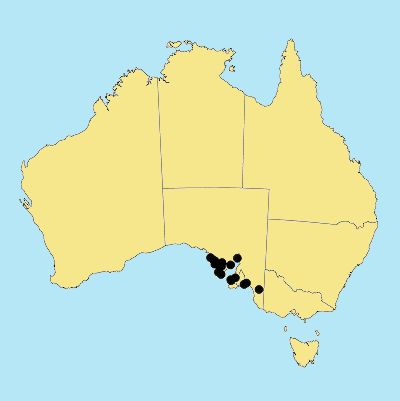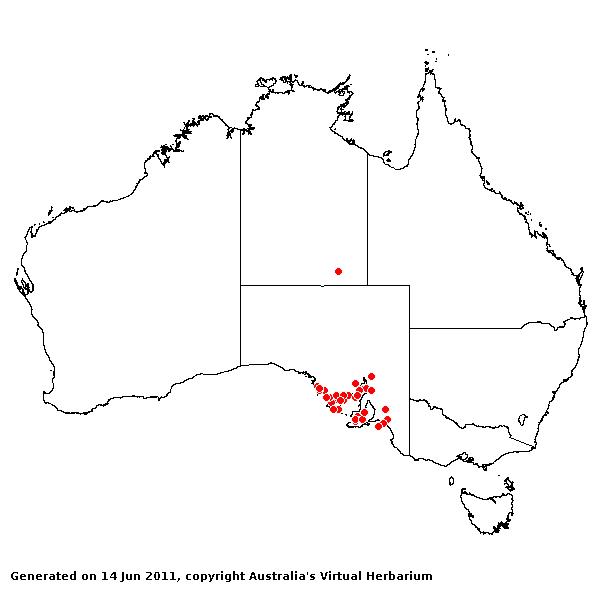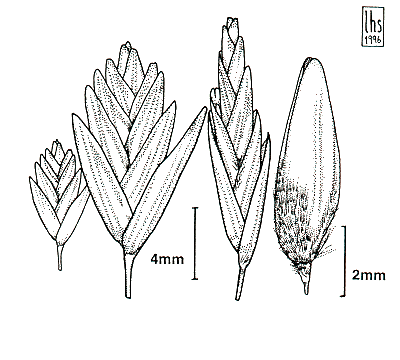Triodia compacta (N.T.
Burbidge) S.W.L. Jacobs. Telopea 4:
653 (1992).
Classification. (GPWG 2001) : Subfamily
Chloridoideae. Triodeae.
Basionym and/or
Replacement Name: Triodia
irritans var. compacta N.T. Burb., Austral. J. Bot. 1(1):
169, f. 15a (1953).
Type of Basionym or
Protologue Information: LT: J.H. Willis s.n., 26 Aug 1947, South
Australia: Eyre Peninsula District; Elliston Beach, Grimwade Expedition 1947
(CANB; ILT: MEL). LT designated by Lazarides, Aust. Syst. Bot. 10(3): 424
(1997).
Key references
(books and floras): [2002] D.Sharp & B.K.Simon, AusGrass, Grasses of
Australia, [2006] J.Jessop, G.R.M.Dashorst, F.M.James, Grasses of South
Australia (412).
Illustrations:
[2005] K.Mallet (ed.), Flora of Australia 44B: Poaceae 3 (Fig.
38)-R), [2006] J.Jessop, G.R.M.Dashorst, F.M.James, Grasses of South
Australia (412, fig. 341).
Habit.
Perennial. Stolons present. Culms 30–120 cm tall. Leaf-sheaths scaberulous,
glabrous on surface. Leaf-sheath auricles absent. Ligule a fringe of hairs,
0.2–0.3 mm long. Leaf-blades erect or ascending or recurved, filiform,
conduplicate, 3.5–13(–19) cm long, 0.8–1.3 mm wide. Leaf-blade surface
scabrous.
Inflorescence.
Inflorescence compound, a panicle. Panicle linear or oblong or ovate, dense,
3.9–26 cm long, 1–2 cm wide.
Spikelets.
Spikelets pedicelled. Fertile spikelets many flowered, with at least 2 fertile
florets (6–13), comprising 6–13 fertile floret(s), with diminished florets at
the apex, lanceolate or elliptic or oblong or ovate, laterally compressed,
11–24 mm long.
Glumes.
Glumes similar, thinner than fertile lemma. Lower glume linear or ovate,
coriaceous, keeled, 1-keeled, 3–5 -nerved. Lower glume surface glabrous. Lower
glume apex muticous. Upper glume linear or ovate, 8.5–13(–16) mm long,
coriaceous, keeled, 1-keeled, 3–5 -nerved. Upper glume surface asperulous,
glabrous. Upper glume apex entire, muticous.
Florets.
Fertile lemma 7–11 mm long, keeled, 9 -nerved. Lemma surface glabrous or
indumented. Lemma apex dentate or lobed, muticous or mucronate. Median
(principal) awn from a sinus. Lodicules present. Anthers 3. Grain 3 mm long.
Continental
Distribution: Australasia.
Australian
Distribution: South Australia.
South Australia:
Eyre Peninsula, Northern Lofty, Murray, Yorke Peninsula, Southern Lofty.
Notes.
Diagnostic characters include the simple relatively small, often partly
enclosed or shortly exserted panicle with glabrous, often smooth and flattened
axis and divisions; closely flowered spikelet with thickened rachilla internode
with cupular apex; 609,usually coriaceous glumes, lemmas and paleas; minutely
2-lobed, emucronate or mucronulate lemma with appressed silky pubescence in the
lower 1/2 or glabrous; glabrous or sparsely pubescent palea with scabrid
wingless keels; relatively short long-pungent blades; strongly branched culms
with many short internodes covered by overlapping sheaths.
.
On
Eyre and Yorke Peninsulas and Southern Lofty District, S.A. Usually coastal, on
sand dunes, limestone cliffs, sea shores, saline and wet flats, sand hills,
rocky hills, brown sandy loam slopes, and skeletal ridge summits; flowers
Aug.-Feb.




